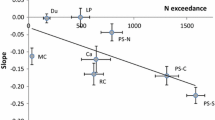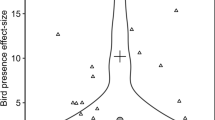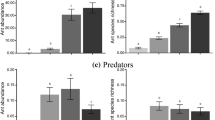Abstract
Humans are increasing the environmental availability of historically limited nutrients, which may significantly influence organismal performance and behavior. Beneficial or stimulatory responses to increases in nitrogen availability (i.e., nitrogen limitation) are generally observed in plants but less consistently in animals. One possible explanation is that animal responses to nitrogen enrichment depend on how nitrogen intake is balanced with sodium, a micronutrient crucial for animals but not plants. We tested this idea in the cabbage white butterfly (Pieris rapae), a species that frequently inhabits nutrient-enriched plants in agricultural settings and roadside verges. We asked (1) whether anthropogenic increases in sodium influence how nitrogen enrichment affects butterfly performance and (2) whether individuals can adaptively adjust their foraging behavior to such effects. Larval nitrogen enrichment enhanced growth of cabbage white larvae under conditions of low but not high sodium availability. In contrast, larval nitrogen enrichment increased egg production of adult females only when individuals developed with high sodium availability. Ovipositing females preferred nitrogen-enriched leaves regardless of sodium availability, while larvae avoided feeding on nitrogen-enriched leaves elevated in sodium. Our results show that anthropogenic increases in sodium influence whether individuals benefit from and forage on nitrogen-enriched resources. Yet, different nitrogen-to-sodium ratios are required to optimize larval and adult performance. Whether increases in sodium catalyze or inhibit benefits of nitrogen enrichment may depend on how evolved nutrient requirements vary across stages of animal development.



Similar content being viewed by others
Data availability
Data will be deposited on Mendeley upon acceptance of the manuscript.
References
Adams T, Pennings SC (2022) Dietary protein and sodium co-limit cockroach growth and reproduction. Ecolog Entomol 47(5):831–841
Altermatt F, Pearse IS (2011) Similarity and specialization of the larval versus adult diet of European butterflies and moths. Am Nat 178(3):372–382
Arms K, Feeny P, Lederhouse RC (1974) Sodium: stimulus for puddling behavior by tiger swallowtail butterflies. Papilio Glaucus Science 185(4148):372–374
Beck J, Fiedler K (2009) Adult life spans of butterflies (Lepidoptera: Papilionoidea+ Hesperioidea): broadscale contingencies with adult and larval traits in multi-species comparisons. Biol J Lin Soc 96(1):166–184
Benes SE, Aragüés R, Grattan SR, Austin RB (1996) Foliar and root absorption of Na+ and Cl− in maize and barley: Implications for salt tolerance screening and the use of saline sprinkler irrigation. Plant Soil 180(1):75–86
Bettez ND, Marino R, Howarth RW, Davidson EA (2013) Roads as nitrogen deposition hot spots. Biogeochemistry 114(1):149–163
Bolker BM (2015) Linear and generalized linear mixed models. Contemporary theory and application, Ecological Statistics, pp 309–333
Borer ET, Lind EM, Firn J, Seabloom EW, Anderson TM, Bakker ES et al (2019) More salt, please: global patterns, responses and impacts of foliar sodium in grasslands. Ecol Lett 22(7):1136–1144
Browne LB (1995) Ontogenic changes in feeding behavior. Regulatory mechanisms in insect feeding. Springer, Boston, MA, pp 307–342
Cape JN, Tang YS, Van Dijk N, Love L, Sutton MA, Palmer SCF (2004) Concentrations of ammonia and nitrogen dioxide at roadside verges, and their contribution to nitrogen deposition. Environ Pollut 132(3):469–478
Chavarria-Pizzaro L, Mccreery HF, Lawson SP, Winston ME, O’Donnell SEAN (2012) Sodium-specific foraging by leafcutter ant workers (Atta cephalotes, Hymenoptera: Formicidae). Ecolog Entomol 37(5):435–438
Chen Y, Ruberson JR, Olson DM (2008) Nitrogen fertilization rate affects feeding, larval performance, and oviposition preference of the beet armyworm, Spodoptera exigua, on cotton. Entomol Exp Appl 126(3):244–255
Da Silva JF, Williams RJP (2001) The biological chemistry of the elements: the inorganic chemistry of life. Oxford University Press
Daliakopoulos IN, Tsanis IK, Koutroulis A, Kourgialas NN, Varouchakis AE, Karatzas GP, Ritsema CJ (2016) The threat of soil salinity: a European scale review. Sci Total Environ 573:727–739
Espeset A, Kobiela ME, Sikkink KL, Pan T, Roy C, Snell-Rood EC (2019) Anthropogenic increases in nutrients alter sexual selection dynamics: a case study in butterflies. Behav Ecol 30(3):598–608
Fay PA, Prober SM, Harpole WS, Knops JM, Bakker JD, Borer ET et al (2015) Grassland productivity limited by multiple nutrients. Nature Plants 1(7):1–5
Finkelstein CJ, CaraDonna PJ, Gruver A, Welti EA, Kaspari M, Sanders NJ (2022) Sodium-enriched floral nectar increases pollinator visitation rate and diversity. Biol Let 18(3):20220016
Fischer K, Fiedler K (2000) Response of the copper butterfly Lycaena tityrus to increased leaf nitrogen in natural food plants: evidence against the nitrogen limitation hypothesis. Oecologia 124(2):235–241
Fox, J., & Weisberg, S. (2011). An R companion to applied regression. Sage Publications.
Han P, Lavoir AV, Le Bot J, Amiens-Desneux E, Desneux N (2014) Nitrogen and water availability to tomato plants triggers bottom-up effects on the leafminer Tuta absoluta. Sci Rep 4(1):1–8
Harpole WS, Ngai JT, Cleland EE, Seabloom EW, Borer ET, Bracken ME et al (2011) Nutrient co-limitation of primary producer communities. Ecol Lett 14(9):852–862
Hebert D, Cowan IM (1971) Natural salt licks as a part of the ecology of the mountain goat. Can J Zool 49(5):605–610
Jackson RB, Jobbagy EG (2005) From icy roads to salty streams. Proc Natl Acad Sci 102(41):14487–14488
Jaenike J (1978) On optimal oviposition behavior in phytophagous insects. Theor Popul Biol 14(3):350–356
Jaumann S, Snell-Rood EC (2017) Trade-offs between fecundity and choosiness in ovipositing butterflies. Anim Behav 123:433–440
Kaspari M (2020) The seventh macronutrient: How sodium shortfall ramifies through populations, food webs and ecosystems. Ecol Lett 23(7):1153–1168
Kaspari M, Clay NA, Donoso DA, Yanoviak SP (2014) Sodium fertilization increases termites and enhances decomposition in an Amazonian forest. Ecology 95(4):795–800
Kaspari M, Roeder KA, Benson B, Weiser MD, Sanders NJ (2017) Sodium co-limits and catalyzes macronutrients in a prairie food web. Ecology 98(2):315–320
Klop E, Omon B, WallisDeVries MF (2015) Impact of nitrogen deposition on larval habitats: the case of the Wall Brown butterfly Lasiommata megera. J Insect Conserv 19(2):393–402
Kurze S, Heinken T, Fartmann T (2017) Nitrogen enrichment of host plants has mostly beneficial effects on the life-history traits of nettle-feeding butterflies. Acta Oecologica 85:157–164
Kurze S, Heinken T, Fartmann T (2018) Nitrogen enrichment in host plants increases the mortality of common Lepidoptera species. Oecologia 188(4):1227–1237
LeBauer DS, Treseder KK (2008) Nitrogen limitation of net primary productivity in terrestrial ecosystems is globally distributed. Ecology 89(2):371–379
Lee KP, Behmer ST, Simpson SJ, Raubenheimer D (2002) A geometric analysis of nutrient regulation in the generalist caterpillar Spodoptera littoralis (Boisduval). J Insect Physiol 48(6):655–665
Mattson WJ Jr (1980) Herbivory in relation to plant nitrogen content. Annu Rev Ecol Syst 11(1):119–161
Mitchell TS, Shephard AM, Kalinowski CR, Kobiela ME, Snell-Rood EC (2019) Butterflies do not alter oviposition or larval foraging in response to anthropogenic increases in sodium. Anim Behav 154:121–129
Mitchell TS, Agnew L, Meyer R, Sikkink KL, Oberhauser KS, Borer ET, Snell-Rood EC (2020) Traffic influences nutritional quality of roadside plants for monarch caterpillars. Sci Total Environ 724:138045
Mitra C, Reynoso E, Davidowitz G, Papaj D (2016) Effects of sodium puddling on male mating success, courtship and flight in a swallowtail butterfly. Anim Behav 114:203–210
Moreau G, Bauce É (2003) Feeding behavior of spruce budworm (Lepidoptera: Tortricidae) larvae subjected to multiple exposures of Bacillus thuringiensis variety kurstaki. Ann Entomol Soc Am 96(3):231–236
Myers JH, Post BJ (1981) Plant nitrogen and fluctuations of insect populations: a test with the cinnabar moth—tansy ragwort system. Oecologia 48(2):151–156
Nessel MP, Konnovitch T, Romero GQ, González AL (2021) Nitrogen and phosphorus enrichment cause declines in invertebrate populations: a global meta-analysis. Biol Rev 96(6):2617–2637
Novotny EV, Sander AR, Mohseni O, Stefan HG (2009) Chloride ion transport and mass balance in a metropolitan area using road salt. Water Resour Res. https://doi.org/10.1029/2009WR008141
Nylin S, Janz N (1993) Ovi position preference and larval performance in Polygonia c-album (Lepidoptera: Nymphalidae): the choice between bad and worse. Ecolog Entomo 18(4):394–398
Peterson TN, Welti EA, Kaspari M (2021) Dietary sodium levels affect grasshopper growth and performance. Ecosphere 12(3):e03392
Pivnick KA, McNeil JN (1987) Puddling in butterflies: sodium affects reproductive success in Thymelicus lineola. Physiol Entomol 12(4):461–472
Plotkin D, Goddard J (2013) Blood, sweat, and tears: a review of the hematophagous, sudophagous, and lachryphagous Lepidoptera. J Vector Ecol 38(2):289–294
Prather CM, Laws AN, Cuellar JF, Reihart RW, Gawkins KM, Pennings SC (2018) Seeking salt: herbivorous prairie insects can be co-limited by macronutrients and sodium. Ecol Lett 21(10):1467–1476
Rengasamy P (2006) World salinization with emphasis on Australia. J Exp Bot 57(5):1017–1023
Reynolds SE, Yeomans MR, Timmins WA (1986) The feeding behaviour of caterpillars (Manduca sexta) on tobacco and on artificial diet. Physiol Entomol 11(1):39–51
Root RB, Kareiva PM (1984) The search for resources by cabbage butterflies (Pieris rapae): ecological consequences and adaptive significance of Markovian movements in a patchy environment. Ecology 65(1):147–165
Ryan SF, Lombaert E, Espeset A, Vila R, Talavera G, Dincă V et al (2019) Global invasion history of the agricultural pest butterfly Pieris rapae revealed with genomics and citizen science. Proc Natl Acad Sci 116(40):20015–20024
Santiago-Rosario LY, Harms KE, Elderd BD, Hart PB, Dassanayake M (2021) No escape: the influence of substrate sodium on plant growth and tissue sodium responses. Ecol Evol 11(20):14231–14249
Schetter TA, Lochmiller RL, Leslie DM Jr, Engle DM, Payton ME (1998) Examination of the nitrogen limitation hypothesis in non-cyclic populations of cotton rats (Sigmodon hispidus). J Anim Ecol 67(5):705–721
Schlaepfer MA, Runge MC, Sherman PW (2002) Ecological and evolutionary traps. Trends Ecol Evol 17(10):474–480
Schlesinger WH (2009) On the fate of anthropogenic nitrogen. Proc Natl Acad Sci 106(1):203–208
Shephard AM, Zambre AM, Snell-Rood EC (2021a) Evaluating costs of heavy metal tolerance in a widely distributed, invasive butterfly. Evol Appl 14(5):1390–1402
Shephard AM, Mitchell TS, Snell-Rood EC (2021b) Monarch caterpillars are robust to combined exposure to the roadside micronutrients sodium and zinc. Cons Physiol. https://doi.org/10.1093/conphys/coab061
Shephard AM, Agnew L, Herdtle A, Mitchell TS, Borer ET, Snell-Rood EC (2022) Traffic patterns, more than adjacent land use, influence element content of roadside forbs for insect pollinators. Ecolog Solut Evid 3(4):e12195
Slansky F Jr, Feeny P (1977) Stabilization of the rate of nitrogen accumulation by larvae of the cabbage butterfly on wild and cultivated food plants. Ecol Monogr 47(2):209–228
Smedley SR, Eisner T (1996) Sodium: a male moth’s gift to its offspring. Proc Natl Acad Sci 93(2):809–813
Smith VH (2003) Eutrophication of freshwater and coastal marine ecosystems a global problem. Environ Sci Pollut Res 10(2):126–139
Snell-Rood EC, Espeset A, Boser CJ, White WA, Smykalski R (2014) Anthropogenic changes in sodium affect neural and muscle development in butterflies. Proc Natl Acad Sci 111(28):10221–10226
Snell-Rood E, Cothran R, Espeset A, Jeyasingh P, Hobbie S, Morehouse NI (2015) Life-history evolution in the anthropocene: Effects of increasing nutrients on traits and trade-offs. Evol Appl 8(7):635–649
Sterner RW, Elser JJ (2017) Ecological stoichiometry. Princeton University Press
Swanson EM, Espeset A, Mikati I, Bolduc I, Kulhanek R, White WA et al (2016) Nutrition shapes life-history evolution across species. Proc R Soc B 283(1834):20152764
Telang A, Booton V, Chapman RF, Wheeler DE (2001) How female caterpillars accumulate their nutrient reserves. J Insect Physiol 47(9):1055–1064
Troetschler RG, Malone CM, Bucago ER, Johnston MR (1985) System for rearing Pieris rapae (Lepidoptera: Pieridae) on a noncruciferous artificial diet developed for Manduca sexta (Lepidoptera: Sphingidae). J Econ Entomol 78(6):1521–1523
Vitousek PM, Aber JD, Howarth RW, Likens GE, Matson PA, Schindler DW et al (1997) Human alteration of the global nitrogen cycle: sources and consequences. Ecol Appl 7(3):737–750
Waldbauer GP, Friedman S (1991) Self-selection of optimal diets by insects. Annu Rev Entomol 36(1):43–63
Watanabe T, Broadley MR, Jansen S, White PJ, Takada J, Satake K et al (2007) Evolutionary control of leaf element composition in plants. New Phytol 174(3):516–523
White TC (1978) The importance of a relative shortage of food in animal ecology. Oecologia 33(1):71–86
White, T. C. (2012). The inadequate environment: nitrogen and the abundance of animals. Springer Science & Business Media
Funding
This study was funded by a grant awarded to KK by the Undergraduate Research Opportunities Program at the University of Minnesota.
Author information
Authors and Affiliations
Contributions
AMS, KK, and ECS-R conceived and designed the experiments. AMS and KK performed the experiments and analyzed the data. AMS wrote the manuscript; other authors provided editorial advice.
Corresponding author
Ethics declarations
Conflict of interest
The authors declare that they have no conflict of interest.
Ethical approval
Ethical approval is not required for non-native insects, such as Pieris rapae.
Additional information
Communicated by Konrad Fiedler.
Supplementary Information
Below is the link to the electronic supplementary material.
Rights and permissions
Springer Nature or its licensor (e.g. a society or other partner) holds exclusive rights to this article under a publishing agreement with the author(s) or other rightsholder(s); author self-archiving of the accepted manuscript version of this article is solely governed by the terms of such publishing agreement and applicable law.
About this article
Cite this article
Shephard, A.M., Knudsen, K. & Snell-Rood, E.C. Anthropogenic sodium influences butterfly responses to nitrogen-enriched resources: implications for the nitrogen limitation hypothesis. Oecologia 201, 941–952 (2023). https://doi.org/10.1007/s00442-023-05366-1
Received:
Accepted:
Published:
Issue Date:
DOI: https://doi.org/10.1007/s00442-023-05366-1




